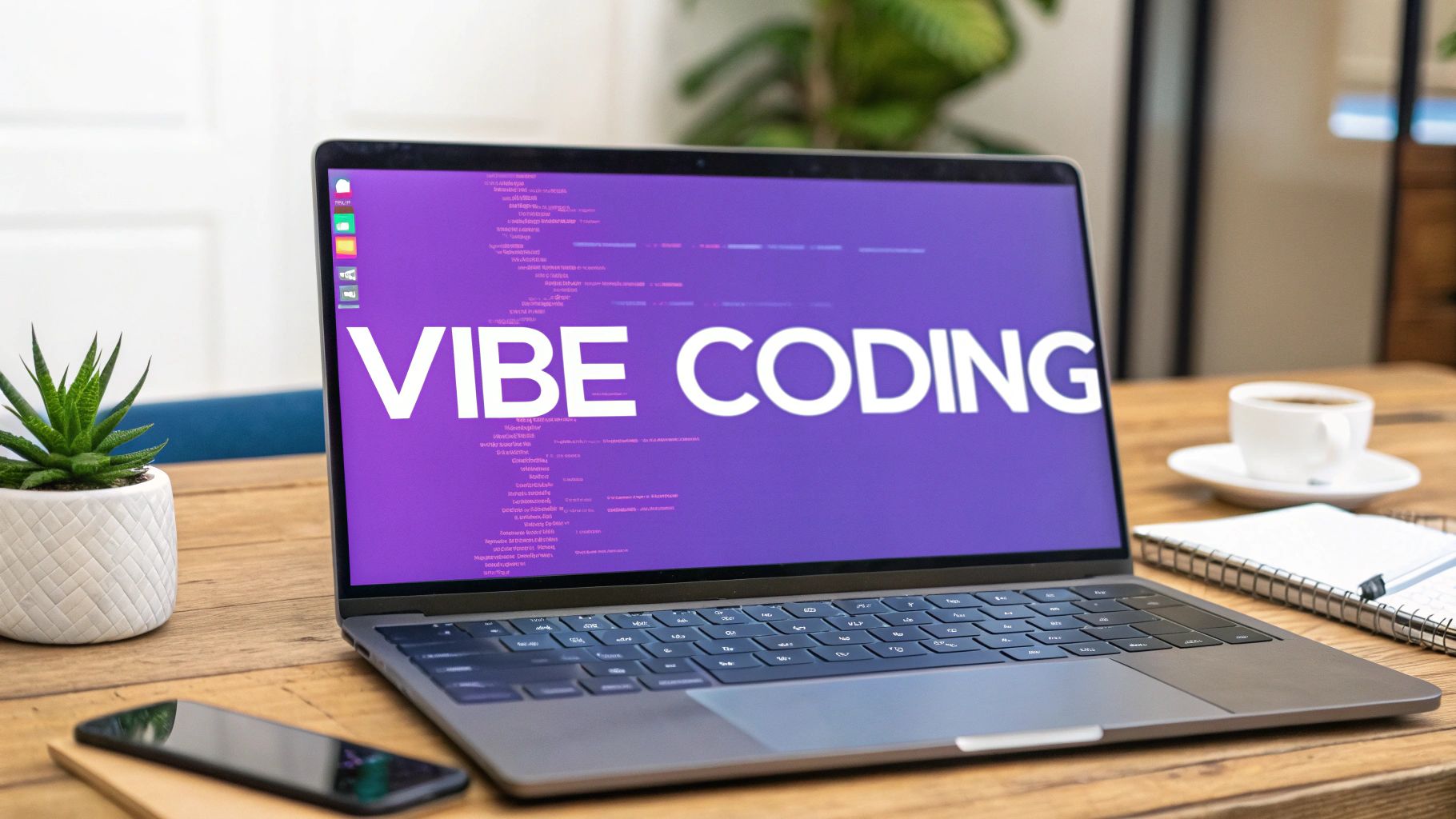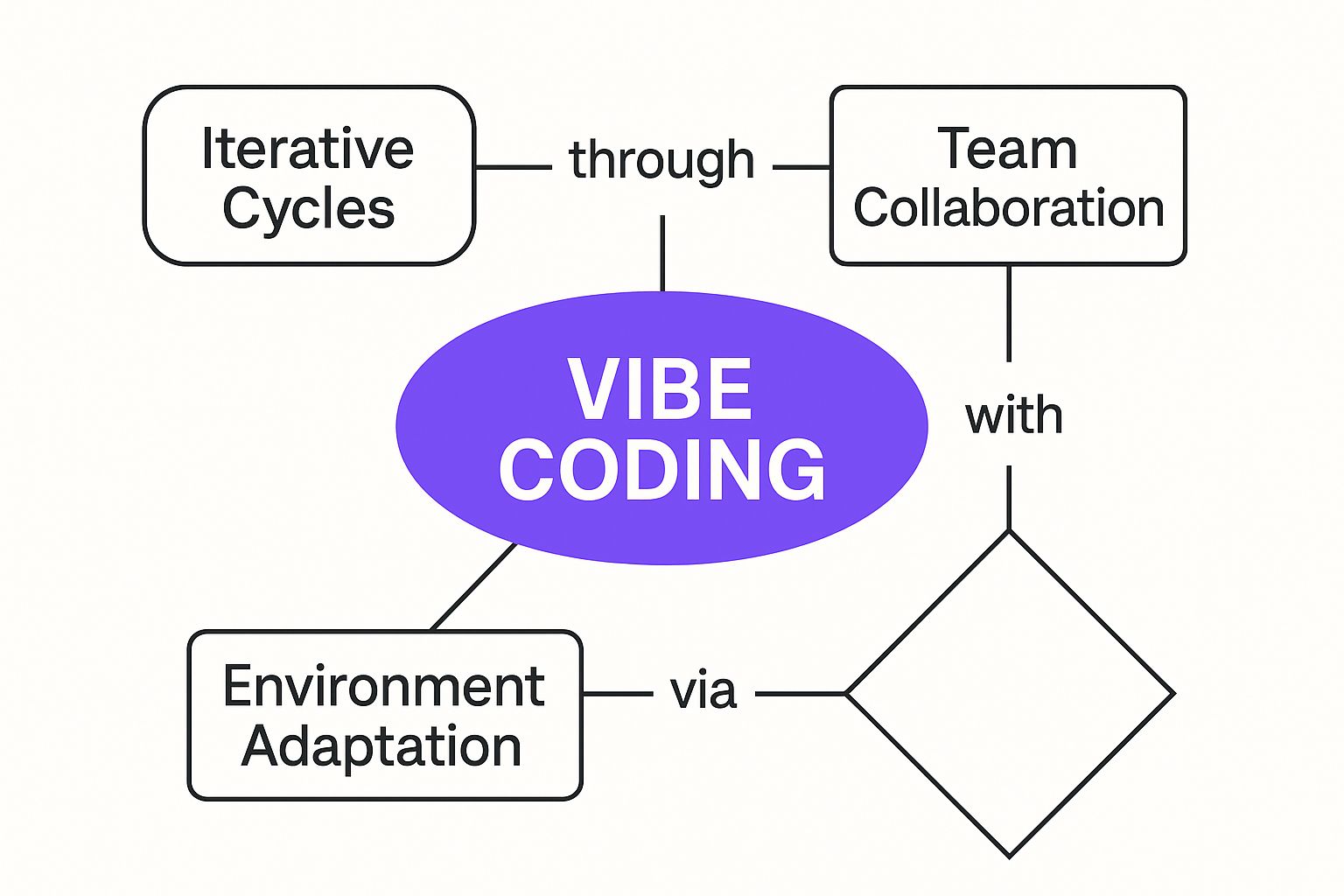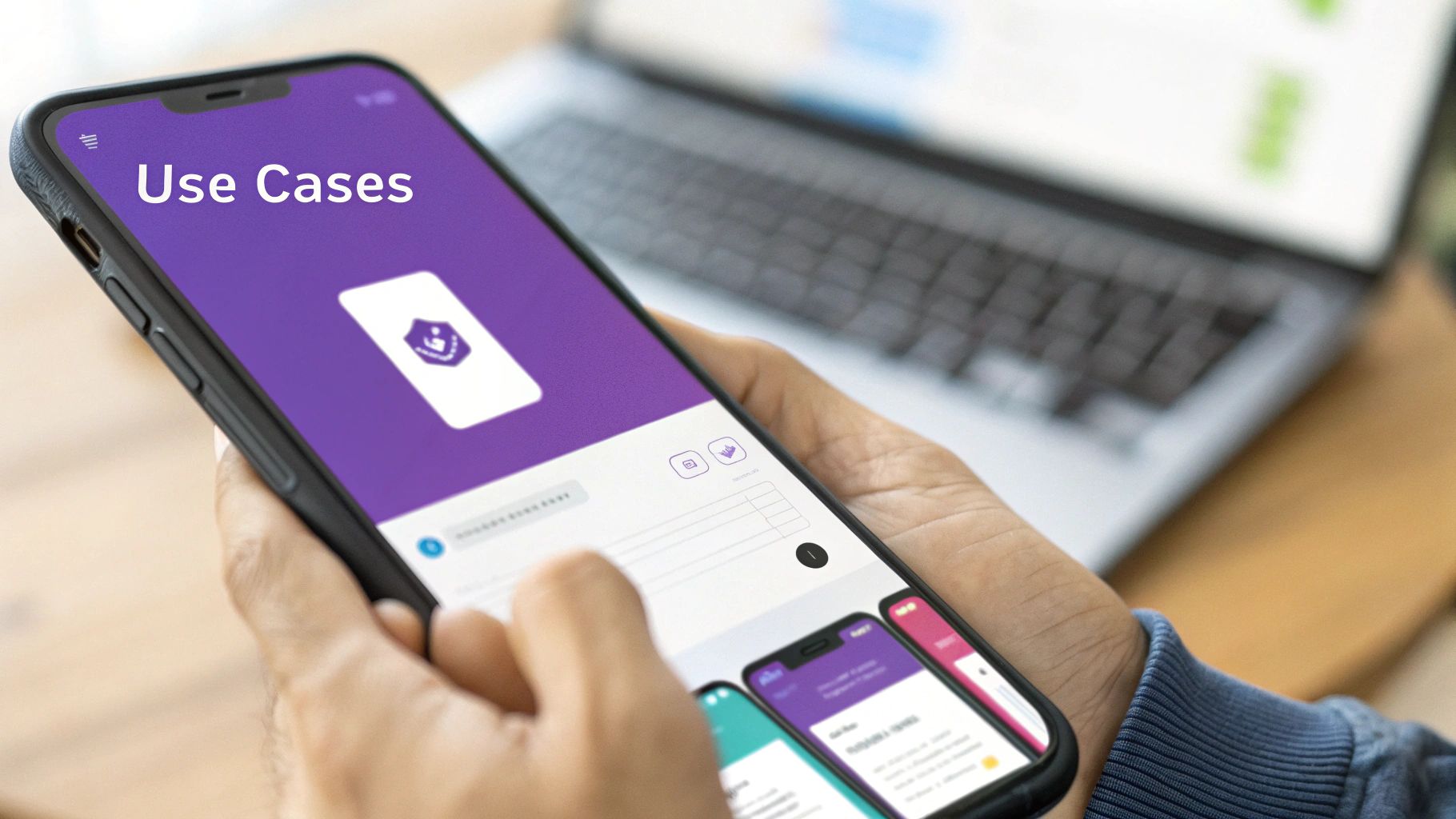What Is Vibe Coding and How Does It Work?

What if you could just describe your dream app, and it would start building itself right before your eyes? That, in a nutshell, is vibe coding. It’s less about writing code and more about expressing a vision, a feeling, and an intent in plain English, then letting an AI handle the heavy lifting. Platforms like the Dreamspace AI app generator are turning this concept into a practical reality.
From Rigid Code to Creative Flow
Vibe coding isn't just a small step forward; it's a complete shift in how we think about building software.
Picture a film director on set. They don't walk around adjusting every single light and camera angle themselves. Instead, they communicate the vibe they're after—the mood, the tension, the feeling of a scene. The crew, with their technical expertise, then translates that feeling into reality.
That's you in the world of vibe coding. You're the director. You provide the high-level concept for your application. It could be something as broad as, "I need a decentralized marketplace for rare digital art with a clean, minimalist feel," or as specific as, "Build me a simple, secure onchain voting system." An AI app generator like Dreamspace takes these instructions and begins the creation process.
The term gained traction thanks to Andrej Karpathy, a co-founder of OpenAI. He framed it as the next evolution of software development, moving away from the painstaking process of writing perfect syntax. Instead of getting bogged down in semicolons and brackets, you focus on describing what you want. You can dive deeper into this new paradigm over on Tanium.com.
So, How Does This Actually Work?
This isn't just some far-off theory. It’s a practical and increasingly powerful way to build real applications. An AI-powered studio like Dreamspace, for instance, acts as your personal app generator. It listens to your ideas and turns them into fully functional onchain apps.
The process is refreshingly simple:
- You start with your idea. You just explain what your app needs to do and, crucially, what it should feel like to use.
- The AI gets to work. It parses your description, figuring out the core logic, user flow, and features.
- Code appears from the ether. The AI generates everything from the user interface and backend logic to the secure smart contracts that power your onchain application.
This diagram breaks down how all the pieces fit together.

As you can see, vibe coding isn't a one-and-done command. It's a living, breathing process. It thrives on quick iterations, creative collaboration, and adapting to new ideas as they emerge. With a vibe coding studio like Dreamspace, you can guide this process in real-time.
To really see the difference, let's put the old and new ways side-by-side.
How AI Turns Your Vibe Into Code

Turning a simple idea into a working piece of software might feel like magic, but it’s really just incredibly sophisticated AI at work. The engine behind this is a Large Language Model (LLM), the same kind of tech you've seen in tools like ChatGPT. The difference is these models have devoured billions of lines of code and practically the entire internet's worth of text.
All that training gives the AI a deep, intuitive understanding of how human intent connects to technical code. It starts to see the patterns. When you describe a "vibe"—like "a slick, minimalist storefront for digital art"—the AI knows exactly which code structures are needed to make that happen. A vibe coding studio like Dreamspace then fine-tunes this entire process specifically for building onchain apps.
So, how does it actually go from your brain to a functioning app? It’s a pretty straightforward path.
- Interpretation: It starts with you. You describe what you want in plain English, focusing on the purpose and feel. The AI listens, breaking down your prompt to get to the core of what you’re trying to build.
- Architectural Mapping: Next, the AI puts on its architect hat. It sketches out the entire blueprint for your app: the user interface, the backend logic, the database structure, and, crucially for onchain apps, the necessary smart contracts.
- Code Generation: With the plan in place, the model gets to work writing the code. Since it's learned from mountains of high-quality code, what it produces is clean, efficient, and up to modern standards.
The Power of AI-Driven Creation
Think of this process less like giving an order and more like a creative partnership. You don’t just hand over a prompt and hope for the best. You're constantly guiding the AI, refining its work with more instructions until the app is a perfect reflection of what was in your head.
The real goal here is to shift development from a rigid, technical chore into a creative conversation. The AI handles the heavy lifting on the code, so you can stay focused on what really matters: the user experience and the big picture.
If you want to dig deeper, it’s worth checking out a breakdown of the best AI app generators to see how different platforms are approaching this. This way of building, pioneered by tools like the Dreamspace AI app generator, lets you create with confidence, even if you’ve never written a line of code in your life.
How Vibe Coding Is Changing App Development
Vibe coding is more than just another productivity hack. It’s a full-blown cultural shift in software, changing who gets to build and how they do it. It’s about tearing down the old walls of technical complexity that kept so many great ideas locked away. Now, entrepreneurs, designers, and thinkers can bring their visions to life without writing a single line of code.
This new way of working opens the doors to creation. By focusing on the what and the why instead of the nitty-gritty how, the playing field gets a whole lot bigger. A vibe coding studio like Dreamspace is at the forefront of this movement, making powerful onchain app development something anyone can do, not just a small circle of specialized engineers.
The impact here is huge. It’s not just about workflow; it's a paradigm shift. Vibe coding allows non-experts to jump into software creation using natural language, dramatically expanding the pool of creators. Even in the heart of Silicon Valley, over 70% of developers agree vibe coding boosts productivity. Of course, change brings uncertainty—around 45% worry about how it will affect jobs over the next decade. You can dig deeper into these trends at ACM.org.
The Evolving Role of the Developer
With this change, the developer’s job is also getting a major upgrade. They’re no longer just manual coders, lost in the weeds of implementation. Instead, they’re becoming vibe architects.
A vibe architect is like a creative director for software. They guide the AI, shape the vision, and make the high-level calls that lead to an amazing final product. They steer the ship while the AI handles the complex rigging.
This evolution is the very soul of the vibe coding movement. It elevates the developer from tedious line-by-line work to strategic oversight and creative problem-solving. This isn't happening in a vacuum; you can see similar shifts across the industry in our guide to the best low-code development platforms. A vibe coding studio like Dreamspace puts developers in this exact role.
Ultimately, it’s this powerful partnership between human creativity and AI efficiency that’s defining what it means to build the future.
Introducing Dreamspace: Your Vibe Coding Studio

It’s one thing to talk theory, but it’s another thing entirely to bring it to life. This is where the whole idea of vibe coding stops being an abstract concept and becomes something you can actually touch and use.
Meet Dreamspace. It’s the first vibe coding studio built from the ground up to turn your onchain app ideas into reality. You don't need to be a developer. You just need a vision.
Think of it as the ultimate collaborator. You describe what you want to build, in plain English, and the platform’s AI gets to work. It’s an AI app generator that listens to your instructions, understands your intent, and translates your unique "vibe" into a working product.
From Vibe to Verified Code
Dreamspace is the bridge between a flash of inspiration and a finished onchain application. It takes your simple prompts and builds out every single piece of the puzzle.
Here’s what that looks like in practice:
- Secure Smart Contracts: The AI doesn't just write code; it generates audited, secure smart contracts. This is the foundation of any web3 project, built for reliability right from the start.
- Polished User Interfaces: Forget clunky, generic templates. Dreamspace creates a clean, responsive front-end designed for a great user experience.
- Integrated Backend Logic: All the server-side plumbing and database connections are handled automatically, making your app fully functional without you writing a single line of code.
Dreamspace is more than just a tool—it's your entire creation suite. It handles all the heavy lifting so you can focus on what really matters: perfecting your idea and sharing it with the world.
This is what makes this new way of building so different. It’s not about spitting out isolated snippets of code. It’s about creating a complete, cohesive application that genuinely reflects your original vision. For anyone looking to build in web3, the Dreamspace vibe coding studio answers the question of what is vibe coding by letting you do it yourself.
The Real-World Benefits of Building with a Vibe

A new way of building is only worth it if it actually delivers. Vibe coding isn't just a cool concept; it's a practical approach that hits your project where it matters most—your timeline, your budget, and your creative freedom.
The first thing you’ll notice is the unmatched speed. Forget the old model of spending months just to get a minimum viable product off the ground. With a vibe coding studio like Dreamspace, you can turn a complex build into something that takes hours or days. That’s it.
This speed naturally leads to the next big win: drastic cost savings. When you aren't paying for massive dev teams or getting stuck in endless project cycles, the cost to launch something ambitious drops through the floor. Suddenly, big ideas become totally possible for small teams, startups, and even solo creators.
Empowering Creation and Iteration
Beyond just being fast and cheap, vibe coding changes the game for who can build and how they perfect their vision. It's all about making the process open and fluid.
- Ultimate Accessibility: You don't need to be a seasoned engineer to build your app anymore. With tools like the Dreamspace vibe coding studio, if you have a clear idea, you can become a builder. Period.
- Effortless Iteration: Get some user feedback? Need to try a new feature? An AI app generator lets you instantly tweak your app just by describing what you want to change. Your project stays nimble and alive.
Vibe coding shifts your focus from writing perfect code to building the perfect product. It’s about getting the user experience and the core idea right through quick, low-cost experiments.
This cycle of building, testing, and refining is what separates good products from great ones. You can see this in action by checking out our guide on building generative AI-powered apps. It walks you through just how fast a concept can become a real, working tool.
Your Questions About Vibe Coding, Answered
As this new way of creating takes hold, you're bound to have questions. Let's cut through the noise and get straight to what matters.
Does Vibe Coding Make Developers Obsolete?
No. It makes them architects.
Instead of writing code line-by-line, the human creator becomes a director, guiding the AI, refining the big picture, and ensuring the final product nails the vision. It’s a partnership. The AI handles the grunt work, freeing up human minds for what they do best: high-level strategy, creative breakthroughs, and perfecting the user experience. A vibe coding studio like Dreamspace is designed to facilitate this exact collaboration.
What Can I Actually Build With This?
The scope of what's possible is growing every day. Right now, platforms like the Dreamspace AI app generator are masters at creating onchain and web3 apps—areas where the fundamental building blocks are understood and can be generated with precision.
Sure, you can build a huge range of fully functional products. But if you're trying to build a massive, hyper-specialized enterprise system, you might still need some traditional code for the truly unique parts. For most new projects and MVPs, though, it’s a total game-changer.
It's the perfect way to get your project off the ground without getting stuck in the weeds of a complex setup.
Can I Trust the AI's Code? Is It Secure?
Security is everything, especially onchain. This isn't an afterthought. Top-tier platforms like the Dreamspace vibe coding studio build their AI models on a foundation of industry best practices and security standards.
The reality is, the AI's code is often cleaner and less prone to the simple human errors that create security holes. These systems run everything through intense testing and validation to make sure the output isn't just reliable, but that it meets or beats the quality of typical human-written code.
Enough reading. Time to build. Dreamspace is the first vibe coding studio for crypto. Generate a production-ready onchain app with AI. No code. Start creating at https://dreamspace.xyz.